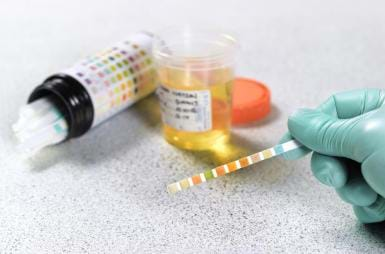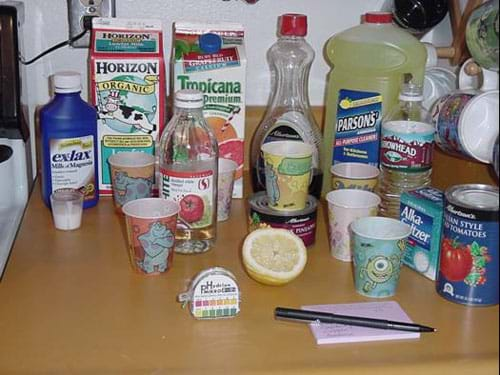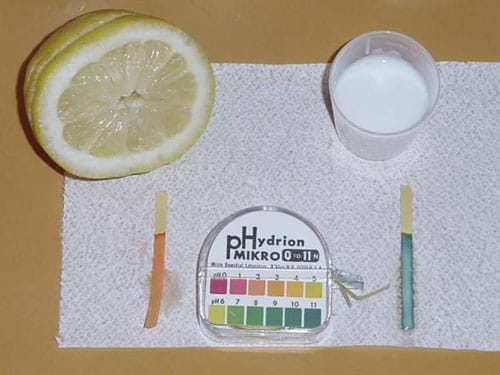Quick Look
Grade Level: 5 (5-6)
Time Required: 1 hour
Expendable Cost/Group: US $3.00
Group Size: 3
Activity Dependency: None
Subject Areas: Chemistry
NGSS Performance Expectations:

| 5-PS1-3 |
Summary
Students are introduced to the differences between acids and bases and how to use indicators, such as pH paper and red cabbage juice, to distinguish between them. They learn why it is important for engineers to understand acids and bases.
Engineering Connection
Measuring pH is fundamental science that is used by many engineers: Environmental and chemical engineers examine pollutant substances to find out whether they are acid or base to know what kind of reactions they cause. Electrical engineers design batteries. Chemical engineers design everything from pharmaceuticals to soap to glue to bubble gum. Civil engineers design water and waste treatment plants for towns and factories. Using the basic concept of acids and bases, engineers are able to create a lot of things that contribute to the health, happiness and safety of society.
Learning Objectives
After this activity, students should be able to:
- Describe some general characteristics of acidic, basic and neutral solutions.
- Calculate and interpret the averages of pH trials.
- Explain why engineers measure the pH of substances with which they are working.
- Use their knowledge of pH to describe some effects of acid rain.
Educational Standards
Each TeachEngineering lesson or activity is correlated to one or more K-12 science,
technology, engineering or math (STEM) educational standards.
All 100,000+ K-12 STEM standards covered in TeachEngineering are collected, maintained and packaged by the Achievement Standards Network (ASN),
a project of D2L (www.achievementstandards.org).
In the ASN, standards are hierarchically structured: first by source; e.g., by state; within source by type; e.g., science or mathematics;
within type by subtype, then by grade, etc.
Each TeachEngineering lesson or activity is correlated to one or more K-12 science, technology, engineering or math (STEM) educational standards.
All 100,000+ K-12 STEM standards covered in TeachEngineering are collected, maintained and packaged by the Achievement Standards Network (ASN), a project of D2L (www.achievementstandards.org).
In the ASN, standards are hierarchically structured: first by source; e.g., by state; within source by type; e.g., science or mathematics; within type by subtype, then by grade, etc.
NGSS: Next Generation Science Standards - Science
| NGSS Performance Expectation | ||
|---|---|---|
|
5-PS1-3. Make observations and measurements to identify materials based on their properties. (Grade 5) Do you agree with this alignment? |
||
| Click to view other curriculum aligned to this Performance Expectation | ||
| This activity focuses on the following Three Dimensional Learning aspects of NGSS: | ||
| Science & Engineering Practices | Disciplinary Core Ideas | Crosscutting Concepts |
| Make observations and measurements to produce data to serve as the basis for evidence for an explanation of a phenomenon. Alignment agreement: | Measurements of a variety of properties can be used to identify materials. (Boundary: At this grade level, mass and weight are not distinguished, and no attempt is made to define the unseen particles or explain the atomic-scale mechanism of evaporation and condensation.) Alignment agreement: | Standard units are used to measure and describe physical quantities such as weight, time, temperature, and volume. Alignment agreement: |
Common Core State Standards - Math
-
Fluently divide multi-digit numbers using the standard algorithm.
(Grade
6)
More Details
Do you agree with this alignment?
-
Fluently add, subtract, multiply, and divide multi-digit decimals using the standard algorithm for each operation.
(Grade
6)
More Details
Do you agree with this alignment?
International Technology and Engineering Educators Association - Technology
-
Explain how knowledge gained from other content areas affects the development of technological products and systems.
(Grades
6 -
8)
More Details
Do you agree with this alignment?
State Standards
Colorado - Math
-
Fluently add, subtract, multiply, and divide multidigit decimals using standard algorithms for each operation.
(Grade
6)
More Details
Do you agree with this alignment?
-
Fluently divide multi-digit numbers using standard algorithms.
(Grade
6)
More Details
Do you agree with this alignment?
Materials List
Parts 1 and 2
Each group needs:
- 10 clear 6-8-oz. cups or Dixie cups to hold test materials
- Masking tape and pen (for labeling cups)
- The following 10 test materials:
- Vinegar (2 samples of about 2 tablespoons each)
- Lemon juice (about 2 tablespoons)
- Tomato or apple juice (pure) (about 2 tablespoons)
- Distilled water (2 samples of about 2 tablespoons)
- Salt water (2 tablespoons of this mix: 3 tablespoons salt in 1 cup distilled water)
- Household liquid bleach (about 2 tablespoons)
- Milk of Magnesia (about 2 tablespoons)
- Baking soda (about 2 tablespoons in 1 cup distilled water)
- Alka-Seltzer tablet
- Alka-Seltzer tablet
- Plus the specific items below, for Part 1 or 2.
Part 1 (only)
Each group needs:
- 30 1.5-inch strips of wide-range (0-14 pH) litmus paper and comparison chart. Students need to use the comparison chart included with the litmus container, so obtain enough dispensers for each group to have one. Purchase litmus paper from a chemistry supply company (such as Fisher) or a well-equipped hardware store.
- pH Values of Common Substances attachment (or as an overhead projector transparency for the entire class to view)
- Measuring pH of Common Substances Data Sheet, and Measuring pH of Common Substances Worksheet, one per student
Part 2 (only)
- Copies of the Cabbage Juice Rainbow Data Sheet, one per student
- Copies of the Red Cabbage Indicator Color Chart (one per group, or one color overhead projector transparency for the entire class to view)
- Cabbage juice for the entire class to share (see materials list, below)
Part 2: Preparation of red cabbage juice for the entire class to share (10 groups):
- 1 small red cabbage
- Cold, distilled water
- Blender (for teacher use only)
- Fine mesh strainer (or funnel and a few coffee filters)
- Large pitcher or beaker
- 10 small jars, beakers or containers (500 ml size, 1 per group)
Alternate Setup: To reduce cost and preparation time, make one sample of each solution and have the students rotate through the samples (instead of each group having each sample). Make numerous water and vinegar samples so that each group has a sample in which to put the Alka-Seltzer. Have each group be in charge of using cabbage juice to test just one of the samples and share data as a class.
Worksheets and Attachments
Visit [www.teachengineering.org/activities/view/cub_air_lesson06_activity1] to print or download.Introduction/Motivation
All substances are divided into three categories — acids, bases and neutral substances. Acids and bases are some of the most important substances on Earth. There are strong and weak acids and bases, and their strengths are described by the pH scale.
Let's use the concept of money to communicate an understanding of acid/base strength. Assign a neutral pH (7) the value of 1 cent. A pH of 6 (or 8) is ten times stronger, so it is worth 10 cents. A pH of 5 (or 9) is ten times stronger than that, so it is worth 100 cents (or $1). A pH of 4 (or 10) is 10 times stronger than that, so it is worth $10.
When environmental engineers investigate a pollutant, they must find out whether the substance is an acid or base in order to know what kind of reactions it causes. Acid rain is an environmental problem that concerns many environmental and chemical engineers. The effects of acid rain include damage to the limestone and marble in statues and buildings; weakening of the exposed metal on bridges and cars; damage to bodies of water, wildlife, plants, forests and crops; and the contamination of the drinking water supply.
One way that we can help prevent acid rain is by burning less fossil fuel. We can also make laws that prevent large factories from burning fossil fuels or that require them to limit (minimize) their pollutant output. Engineers have developed many useful technologies for this purpose, but the companies must adhere to the laws. For example, emissions from cars have been reduced because cars now have catalytic converters that remove the poisonous gases from exhaust fumes.
Unfortunately, as we studied in the lesson On the Move: Transport & Weather, air and wind can move pollutants great distances. In fact, pollutants that contribute to acid rain may be carried hundreds of miles by wind before being deposited on the Earth. Because of this, it is sometimes difficult to determine the specific sources of these acid rain pollutants. For example, Canada has an acid rain problem because of manufacturing in the mid-western states of the U.S. Sulfur dioxides are produced in the industries in Ohio, Illinois and Pennsylvania, and are carried over the land by the weather patterns. The acids then combine with rain over Canada and the Adirondack mountains in New York, making those lakes lifeless.
Procedure
Background: Identifying Acids and Basis
Use the following information to help in the identification of acids and bases.
Characteristics of Acids
- Tastes sour.
- Turns litmus paper red.
- Turns cabbage juice red.
Characteristics of Bases
- Tastes bitter.
- Feels slimy.
- Turns litmus paper blue.
- Turns cabbage juice yellow, green or blue, depending upon the solution concentration.
Acid/Base Indicators
- Indicators change color with different pH values.
- Litmus paper is frequently used to investigate the pH of substances. The more basic a substance, the bluer the indicator turns. The more acid, the redder the paper turns.
- Cabbage juice can be used to make a rainbow of colors corresponding to various (approximate) pH values.
More about Acid-Base Indicators in Red Cabbage
Red cabbage contains two main types of plant dyes: anthocyanin and flavonol. Anthocyanin pigments are red in strongly acidic solution, blue in neutral and weakly basic solutions, and colorless in strongly basic solutions. Weakly acidic solutions contain some of the red form and some of the blue form and thus appear purple. Flavonol pigments are colorless in acidic and neutral solutions, and yellow in basic solutions. Weakly basic solutions thus contain both blue (anthocyanin) and yellow (flavonol) dyes, and appear to be green. The pH corresponding to various colors varies slightly with concentration, solvent, age and variety of cabbage. Most flowers and fruits contain anthocyanin as pigments.
Before the Activity
- Prepare the cabbage juice indicator the morning of the experiment (see below for instructions).
- Gather materials (see Figure 1). If time permits, place samples of the 10 test substances into small cups.
- Make copies of the handouts.
Cabbage Juice Preparation
- Place small pieces of cabbage into a blender.
- Pour cold, distilled water into the blender and let it sit for one hour.
- Blend on high speed until thoroughly mixed.
- Strain the cabbage juice into a pitcher/beaker using a strainer (or a funnel and coffee filters).
- Place samples in small jars or containers, one for each student group.

With the Students: Part 1 – Using pH Paper
- Distribute 10 cups, 2 Alka-Seltzer tablets, pH paper and Measuring pH of Common Substances Data Sheets and Worksheets to each group.
- Ask students to record on their data sheets their predictions for the pH of each item.
- Demonstrate the use of pH paper. For example, ask each student to test the pH of the lemon juice, and show them how to use the comparison chart on the pH paper package to determine the pH. You may also want to demonstrate how to calculate the average pH (a sample calculation may be found at the bottom of their data sheets).
- Ask the students to finish testing each of the 10 items (see Figure 2). Have them add one Alka-Seltzer tablet to one of the water samples and one of the vinegar samples. Ask the students to record all tests on their data sheets and establish whether each item is an acid or base.
- Have students compare their results to the items listed on the attached pH Values of Common Substances.
- Have students answer the questions on their Measuring pH of Common Substances Worksheet.

With the Students: Part 2 – Using Cabbage Juice
- Explain to the students that cabbage juice is a natural substance that can be used to test (indicate) for acids or bases.
- Provide each group with a color printout, or show the class a color overhead projector transparency (Red Cabbage Indicator Color Chart attachment) of the range of cabbage juice color changes, corresponding to whether the solution is an acid or base.
- Distribute a Cabbage Juice Rainbow Data Sheet and a container of cabbage juice to each group.
- Ask students to make predictions about the expected color change for each substance and record this on their data sheets. They should guess fairly accurately if they were paying attention in Part 1.
- Ask each group to add cabbage juice to each of the cups until they see a color change. If you like, you can have students measure how much cabbage juice they are adding.
- Have students record their results on their data sheets.
- Discuss/compare results as a class.
Assessment
Pre-Activity Assessment
Predictions: Ask students to record their predictions for the pH of each item on their Measuring pH of Common Substances Data Sheet.
Activity Embedded Assessment
Data Sheets: Ask students to record all tests on the data sheets and establish whether each item is an acid or base.
Post-Activity Assessment
Discussion: Ask students what they have learned. Ask if there were any surprises. Discuss student answers to questions on the Measuring pH of Common Substances Worksheet.
Human pH Scale: On separate pieces of paper, write the names of the different substances you tested. Ask for volunteers from the class to come up to the front of the room, and give each one of the pieces of paper. Have all volunteers read what is written on their papers one at a time. Have the rest of the class label them as acid, base or neutral by voting. Have students "terms" stand in order on the pH scale. At the end, review the concepts learned.
Safety Issues
- Check with students about allergies to food and other substances used in this activity.
- Be sure to explain that scientists and engineers never test substances by tasting them (even though we know that some of the things we are working with are edible)!
- Direct supervision is necessary when working with these materials since some may be irritating to the nose or skin.
Troubleshooting Tips
You may want students to use calculators when calculating averages.
Activity Extensions
What happens to pH when you mix acids and bases? Students can add baking soda into each cup containing an acid. Measure how much baking soda must be added to return the cabbage juice to the original color. Make sure they keep one cup with only cabbage juice, as a control. The stronger the acid, the more baking soda must be added to return to the original color.
Determine the proportions of vinegar and baking soda necessary to create a neutral substance.
Use electronic pH probes to obtain more accurate pH information.
Test different antacids to see which type is the most effective.
Explore the damaging effects of acid on the environment.
Activity Scaling
- For lower grades, use fewer examples and test them as a class demonstration.
- For lower grades, the concept of "average" may be difficult, so consider eliminating this portion or come up with a class average for the pH of a given substance.
- For lower grades, have students make a bar graph detailing their results.
Subscribe
Get the inside scoop on all things TeachEngineering such as new site features, curriculum updates, video releases, and more by signing up for our newsletter!More Curriculum Like This

Students are introduced to acids and bases, and the environmental problem of acid rain. Students also conduct a simple experiment to model and discuss the harmful effects of acid rain on our living and non-living environment.

Students learn the basics of acid/base chemistry in a fun, interactive way by studying instances of acid/base chemistry found in popular films such as Harry Potter and the Prisoner of Azkaban and National Treasure. Students learn what acids, bases and indicators are and how they can be used, includi...

Students explore the effect of chemical erosion on statues and monuments by experimenting with chalk (to represent limestone) placed in liquids of different pH values. They also learn what engineers are doing to reduce the effects of acid rain.

Students conduct a simple experiment to model and explore the harmful effects of acid rain (vinegar) on living (green leaf and eggshell) and non-living (paper clip) objects.
References
Acid Rain Lesson Plan (Grades 6-8). Updated December 18, 2003. National Park Service. Accessed August 16, 2004. (Activity adapted from this source.) Originally found at: http://www.nature.nps.gov/air/edu/Lessons/AcidRLessonPlan.cfm
Results of Adding Cabbage Juice to Solutions of Different pH Values. CSU Stanislaus Science Web, Turlock, CA. Accessed November 9, 2004. (Source of red cabbage indicator color chart attachment) Originally found at: http://wwwchem.csustan.edu/chem3070/images/cabbage.gif
Copyright
© 2004 by Regents of the University of Colorado.Contributors
Amy Kolenbrander; Sharon Perez; Janet Yowell; Natalie Mach; Gwendolyn Frank; Malinda Schaefer Zarske; Denise CarlsonSupporting Program
Integrated Teaching and Learning Program, College of Engineering, University of Colorado BoulderAcknowledgements
The contents of this digital library curriculum were developed under a grant from the Fund for the Improvement of Postsecondary Education (FIPSE), U.S. Department of Education and National Science Foundation GK-12 grant no. 0338326. However, these contents do not necessarily represent the policies of the Department of Education or National Science Foundation, and you should not assume endorsement by the federal government.
Last modified: May 23, 2021









User Comments & Tips